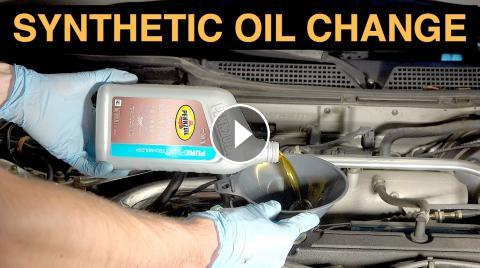How to change your oil with synthetic oil. Changing your oil is probably the most important maintenance item for the longevity of your car. It needs to be done regularly at mileage or time intervals (whichever comes first) to keep your car running properly (check your individual owners manual for service intervals). Though it can be done in shops cheaply, by doing it yourself you can ensure you use a quality oil and a quality oil filter, and that it's done right. Follow these 15 steps to change your oil, which I'll be doing on my 1999 Acura Integra using Pennzoil Platinum synthetic motor oil. This video is brought to you by Pennzoil, all opinions are completely my own.
Related Videos
Lift Car Onto Jack Stands - https://youtu.be/t6TRIRaAZwY
Motor Oil Myths - https://youtu.be/Se8-W7rK0H4
Fuel & Oil Development - https://youtu.be/pUr7-Ug1Uqc
15 Step Procedure To Change Your Oil #DIYOilChange
1. If the car has run recently, the oil will drain faster since it is warm. Be careful not to touch anything hot.
2. Put the car up on jack stands (I have a separate video explaining how to do this I will link in the video description). Make sure the vehicle is stable, do this on flat ground. Be sure to place chocks behind the rear wheels.
3. Locate the drain plug on the oil pan. Check the owners manual if you’re not sure where this is. Place a drain tub underneath the drain plug. Unscrew the drain plug. Allow the oil to drain into the pan. Be careful as the oil will be hot.
4. Once oil has stopped draining, remove the oil filter. Unscrew it slightly at first to allow oil to drain out (this may require a special tool depending on how tight it is, you can rent these at your local auto parts shop).
5. After oil has stopped draining from the loosened filter, you can remove it. Dump the excess oil in the filer into the pan.
6. Use a small amount of oil and rub it on the oil gasket of the new filter. Also ensure the rubber gasket from the old oil filter is not stuck to the car.
7. Screw the new oil filter on. After the rubber seal seats, tighten the oil filter 7/8th of a clockwise turn per the service manual. You can also use a torque of 16 lb-ft per the service manual.
8. Screw down the drain bolt, making sure to replace the (14 mm) crush washer located between the pan and the bolt. For an Integra, torque to 33 lb-ft per service manual.
9. Clean any oil that may remain on the car off from the drain plug or oil filter. Oil could drip on the exhaust and burn off.
10. Pull the drain tub out from under the car, and lower the car back down.
11. Unscrew the oil fill cap, and add the recommended quantity and type (4.0 quarts of 5W-30; ~3.8L) into the engine.
12. Screw the oil cap back on.
13. Run the car for a few minutes, then shut it off. Check underneath the car for any oil leaks, and address as needed.
14. Be sure to check the oil fill level (using the dipstick) after you’ve run the engine. This will ensure the oil filter is full and you’ve filled the oil to the correct level. Add oil if needed.
15. Dispose of the oil properly. Many auto parts stores or shops will take it and recycle it. Some cities may allow for you to place the oil in a jug at the curb for recycling. This goes for the oil filter as well.
3 Benefits Of Natural Gas Based Oil
- Volatility Control: Based on ASTM D5800 testing
- Low Temperature Performance: Based on ASTM D4684 MRV TP-1at negative 31 deg F.
- Oxidation Stability: Based on ASTM D7528 "ROBO" oxidation test at negative 22 deg F & ASTM D7320 at 212 deg F.
Related Videos
Lift Car Onto Jack Stands - https://youtu.be/t6TRIRaAZwY
Motor Oil Myths - https://youtu.be/Se8-W7rK0H4
Fuel & Oil Development - https://youtu.be/pUr7-Ug1Uqc
15 Step Procedure To Change Your Oil #DIYOilChange
1. If the car has run recently, the oil will drain faster since it is warm. Be careful not to touch anything hot.
2. Put the car up on jack stands (I have a separate video explaining how to do this I will link in the video description). Make sure the vehicle is stable, do this on flat ground. Be sure to place chocks behind the rear wheels.
3. Locate the drain plug on the oil pan. Check the owners manual if you’re not sure where this is. Place a drain tub underneath the drain plug. Unscrew the drain plug. Allow the oil to drain into the pan. Be careful as the oil will be hot.
4. Once oil has stopped draining, remove the oil filter. Unscrew it slightly at first to allow oil to drain out (this may require a special tool depending on how tight it is, you can rent these at your local auto parts shop).
5. After oil has stopped draining from the loosened filter, you can remove it. Dump the excess oil in the filer into the pan.
6. Use a small amount of oil and rub it on the oil gasket of the new filter. Also ensure the rubber gasket from the old oil filter is not stuck to the car.
7. Screw the new oil filter on. After the rubber seal seats, tighten the oil filter 7/8th of a clockwise turn per the service manual. You can also use a torque of 16 lb-ft per the service manual.
8. Screw down the drain bolt, making sure to replace the (14 mm) crush washer located between the pan and the bolt. For an Integra, torque to 33 lb-ft per service manual.
9. Clean any oil that may remain on the car off from the drain plug or oil filter. Oil could drip on the exhaust and burn off.
10. Pull the drain tub out from under the car, and lower the car back down.
11. Unscrew the oil fill cap, and add the recommended quantity and type (4.0 quarts of 5W-30; ~3.8L) into the engine.
12. Screw the oil cap back on.
13. Run the car for a few minutes, then shut it off. Check underneath the car for any oil leaks, and address as needed.
14. Be sure to check the oil fill level (using the dipstick) after you’ve run the engine. This will ensure the oil filter is full and you’ve filled the oil to the correct level. Add oil if needed.
15. Dispose of the oil properly. Many auto parts stores or shops will take it and recycle it. Some cities may allow for you to place the oil in a jug at the curb for recycling. This goes for the oil filter as well.
3 Benefits Of Natural Gas Based Oil
- Volatility Control: Based on ASTM D5800 testing
- Low Temperature Performance: Based on ASTM D4684 MRV TP-1at negative 31 deg F.
- Oxidation Stability: Based on ASTM D7528 "ROBO" oxidation test at negative 22 deg F & ASTM D7320 at 212 deg F.
- Category
- Autos & Vehicles













Comments